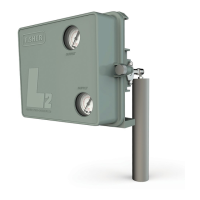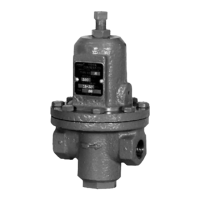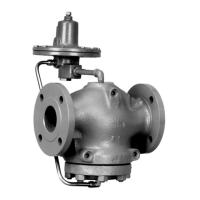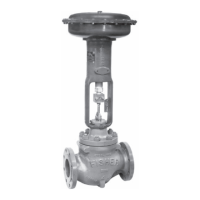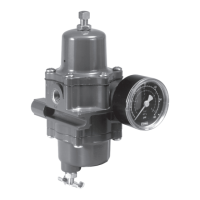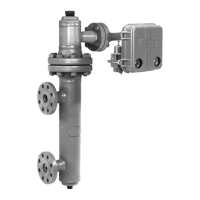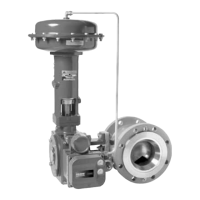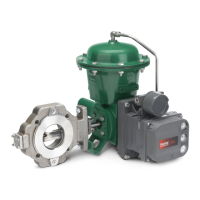4195KA, KB, KC, and KS Controllers
Instruction Manual
Form 5207
April 2007
6-31
9. Adjust the proportional band to 5 percent
REVERSE. Turn flapper leveling screw 1 (the screw
nearest the nozzle) until the nozzle just touches the
flapper.
10. Flapper leveling screws 1 and 3 should protrude
the same distance from the clinch nuts. A clinch nut
is shown in figure 6-16.
11. If leveling screw 1 protrudes further than
leveling screw 3, turn the link 3 adjusting screw
counterclockwise. If leveling screw 3 protrudes
further than leveling screw 1, turn the link 3 adjusting
screw clockwise.
12. Repeat steps 8 through 11 until leveling screws
1 and 3 protrude an equal distance from the clinch
nuts.
13. Perform the controller calibration procedures
and, if necessary, the appropriate remote set point
calibration procedure in Section 3, 4, or 5.
Replacing Capsular Element Controller Link 4
1. Remove the two screws (key 6), and lift off the
proportional band indicator cover (key 36).
2. Disconnect link 4 from the bellows bracket (key
31) and the flapper assembly (key 11).
3. Connect the replacement link to the flapper
assembly so that the two adjusting screws on the
link are nearest to the bellows bracket (key 31) and
so that the screw heads are facing the bottom of the
controller as shown in figure 6-21.
4. For controllers with reset (4195KB Series) or
reset and rate adjustments (4195KC Series), turn
the reset adjustment to the CLOSED (4195KB) or
OFF (4195KC) position. Turn the rate adjustment
(4195KC Series) to the OFF position.
The controller output must be 0 bar (0 psig). To be
sure the controller output is at 0 bar (0 psig), remove
supply pressure, set the reset adjustment to 0.01
minutes per repeat and wait 30 seconds; then, turn
the reset adjustment to the CLOSED (4195KB) or
OFF (4195KC) position.
5. Adjust the proportional band to 5 percent
REVERSE and move the set point indicator to the
process scale upper limit.
6. Disconnect link 1 from the pivot arm. Tape the
process pointer to the process scale lower limit (the
last mark on the left side of the scale).
7. Apply the correct supply pressure to the
controller. The output of the controller should be
within 0.14 bar (2 psig) of supply pressure. If not,
adjust flapper leveling screw 1 (the screw nearest
the nozzle) until the output is within 0.14 bar (2 psig)
of supply pressure.
8. Loosen the two adjusting screws on link 4.
Connect the free end of the link to the bellows
bracket and allow the link to find its free length.
9. Tighten the two adjusting screws on the link.
10. Raise link 4 out of the hole in the bellows
bracket (key 31) and ensure that it drops back into
the hole under its own weight. If not, repeat steps 8
and 9.
11. For a controller with reset, adjust the reset
adjustment to 0.01 minutes per repeat. The rate
adjustment (4195KC) should remain in the OFF
position.
12. The controller output should be within 0.14 bar
(2 psig) of the supply pressure. If not, adjust flapper
leveling screw 1 (the screw nearest the nozzle) until
the output is within 0.14 bar (2 psig) of supply
pressure.
13. Remove the tape from the process pointer and
connect link 1 to the pivot arm.
14. Perform the controller calibration procedures
and, if necessary, the appropriate remote set point
calibration procedure in Section 3, 4, or 5.
Replacing Capsular Element Controller Link 5
1. Remove the two screws (key 6), and lift off the
proportional band indicator cover (key 36).
2. Note the location of the connection holes and
disconnect both ends of link 5 (key 88) from the
lever arms of the two pivot assemblies. Refer to
figure 6-22 for parts locations.
3. Loosen the adjustment screw on the replacement
link and adjust the length to match the original link.
Tighten the adjustment screw.
4. Attach the replacement link to the two lever arms
in the same holes noted in step 2.
5. Move the set point indicator, either manually or
with remote set point pressure, to the mid-scale
mark on the process scale and set the proportional
band between DIRECT and REVERSE.
6. The process pointer should be aligned with the
pointer subassembly as shown in figure 6-15. If not,
loosen the zero adjustment locking screw and adjust
the process pointer zero adjustment to align the
process pointer and pointer subassembly. Tighten
the zero adjustment locking screw.
7. Apply process pressure equal to the mid-scale
value of the process scale span. The process
pointer should indicate the mid-scale ±3 percent of
the scale span. If not, loosen the screw in link 1 or
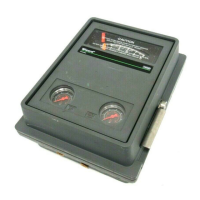
